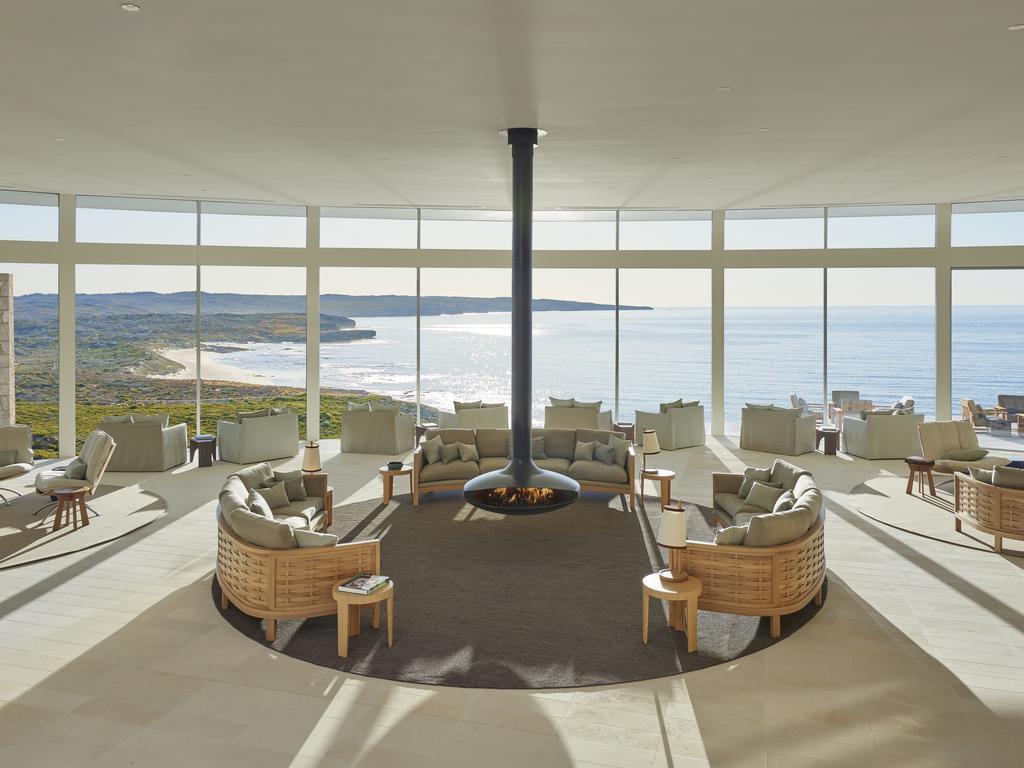Inside Raffles Bali where villas are $1400 a night
The new luxury resort in Jimbaran Bay is a wonderland of greenery that would rival any major city’s botanic gardens.

There is alchemy at play across the recently opened Raffles Bali estate in the island’s south. I don’t spy fairies or pixies but the magic is palpable. Mother Nature has dealt the winning hand, showing off a bounty of sea, sand, cliffs, rocky outcrops, rushing stream and plunging valley.
Imaginative landscaping and the careful attention of a team of 40 khaki-clad gardeners ensures plantings flourish across a 23ha wonderland that would rival many a major city’s botanic garden.
This perched parcel of land beside Jimbaran Bay, with private sandy cove and sheltering headland, had long been coveted by major tourism operators for its direct beach access and fortuitous proximity to tourist attractions and Denpasar airport.

The owners sealed the deal several decades ago, building started in 2016, and Raffles was appointed as operator, no doubt thanks to both its international reputation and a plan of low-rise architecture by Grounds Kent Arsitek Indonesia to merge, not impinge, on the territory. Unsurprisingly, accolades and widespread acclaim have followed.
There are 32 stand-alone villas, set in cascading tiers, all with water views. Some offer two bedrooms, and category prices determine if guests get a high glimpse or full panorama but there are no bad seats, as it were, and I like the democracy of this.

All are hunkered within stone walls, set in flowering, statue-dotted gardens, and offering a sense of utter privacy. Interior inclusions follow a template of polished timbers, rattan, bamboo, earthy tones, and batik patterns stamped on a feature wall above the massive bed. There are indoor-outdoor showers, those nifty Toto loos with saluting lids, deep bathtubs, large dressing rooms and myriad seating options.
The signature Raffles regard for detail is clearly in evidence, from the supply of brimmed hats, woven fans and beach bags to best-quality Dammann Freres tea leaves in refillable tins. Bathroom amenities come in ceramic containers and water in refillable glass bottles.
There’s an Illy coffee machine, healthy snacks and treats, and fridges stocked with complimentary non-alcoholic drinks, including jamu tonics made with the likes of ginger, lime, guava, turmeric, beetroot and hibiscus.

A wooden bowl holds rambutan, snake fruit and other knobbly exotics. A tiny “wellbeing garden” of crunchy vegetables and sambal appears one evening on a tray during turndown service. Glistening with virtuousness, it’s as exactly proportioned as an ikebana arrangement.
Book an in-villa dining experience for a gentle ceremony of food and service free of intrusiveness and with the bonus of between-course dips. Your butler (all villas have one, or even two) will make arrangements.
In our case, Endah has a day off so Bella takes over, and we are blessed to meet both these clever young women with their sunbeam smiles and good humour.

Each villa has a well-proportioned infinity-edge private pool. Sunbeds and a thatch-roofed pavilion set with cushions and bolsters beckon for lolling and snoozing.
Dragonflies buzz like miniature helicopters, butterflies dance, lizards skitter, and geckoes utter their uh-oh signals, always suggestive of a moment of mild panic. Small birds swoop in circles, performing an avian ballet. Finches, swifts, wrens?
Later, I show my iPhone snap to a gardener who nods and replies, “We call these ones brown birds.” Perfect. And the ones with chestnut crowns? “Eurasian tree sparrows,” he replies. “But we call them church birds.”

More intriguing information is garnered on a guided botanical tour aboard a golf buggy with marketing executive Cindi to appreciate the sheer scope of the estate and the proliferation of fuzzy green growth after recent rain.
Off we go, up and down winding paths scattered with frangipani petals and bordered by low limestone walls. We visit the farm terrace and prospering herb garden, rich with witchy and almost medicinal smells, and its hive where stingless bees preside, their honey rich in jackfruit and mango; its strong, slightly sour taste proves oddly addictive.
We learn that “climbing cows that think they are goats” sometimes lumber up from neighbours’ farmland to have a munch at the plots. But gardeners are clearly on high alert for such delinquent behaviour.
We drive under arbours of passionfruit vines, past tamarind trees and hedges blazing with bougainvillea, clock the traveller’s palms that instantly remind of the Raffles Singapore mothership, inspect the nursery and spy ginger flowers that look almost ready to replant in villa gardens.

In an orchard grove are bananas, pandan, kaffir limes, ancient banyans of immense girth, plus Indian ash trees that produce a molasses-like resin that is diluted as a fertiliser and cleaning agent. One deep-rooted species of ficus has drooping heart-shaped leaves and as Cindi and as I stand under the canopy, we almost disappear from view.
Dotted throughout are small temples to the deities decked with bright blooms and leaf-wrapped offerings.
Estate produce features prominently in the high-ceilinged main restaurant, fortuitously named Rumari (house of the full moon and the sun), which weaves from the airy lobby, where a guardian limestone boulder stands as centrepiece. The open-sided deck is the perfect spot for observing swift sunsets.
Cashews are harvested from the estate for the culinary brigade to magic up nutty butter and ice-cream. Edible blooms decorate almost every dish; the kitchen staff are clearly having fun with liberal flower showers.

Breakfasts are so generous, complete with foam-cuffed fruit juices, that lunch becomes a redundant notion. Culinary director Gaetan Biesuz hails from France, so expect buttery, flaky pastries and his promised “fresh surprises” daily.
The cocktail hour is popular and, this being a Raffles property, a moodily lit Writers Bar in the original Singapore template with a small library and art collection draws in those inclined for a Bali sling made with sturdy arak or a jamu reviver, plus the expected colourful concoctions.
A tangerine sour, anyone? Leisurely opening hours of noon to midnight allow plenty of time to partake, even just for a virtuous pot of tea made with dried rosella flowers or coffee sourced from Sumatra.
Loloan Beach Bar and Grill, open noon to late, is set beside the 25m pool, lined with lounging cabanas, and the feel is distinctly Mediterranean in palette and design. The name translates to its estuary setting and the chefs serve up the likes of burrata salads, wood-fired pizzas and pasta primavera; all would pass muster on the Amalfi Coast. Scoops of sorbet made from Asian fruit and ginger ice-cream add a tropical context, seafood comes fresh from local fishermen.
It’s very groovy and has a level of privacy and agreeably muted sound system that are lacking at most Bali beach clubs.

For further indulgence, Sanctuary Spa, entered through huge ceremonial doors, is small and serene, attended by young therapists with the grace and whispered voices of temple maidens. There are scrubs and rubs, massages and treatments based on Balinese healing principles.
A floral footbath starts proceedings and a singing bowl session follows, which proves oddly calming. An hour after a classic massage and vigorous head rub, I sip milk from a young coconut spiked with a straw and contemplate taking an afternoon siesta there and then, until Bella appears to lead me gently away.
The environmental conscience is strong, too. As just a few examples, airconditioning cuts out when villa doors are opened, straws are made from cassava starch, eggshells repurposed into organic fertiliser, and use of plastics is minimal. Ratio of locally sourced to imported ingredients is 80/20.
What does not need to be accounted for is the sense of peace and privacy and a rare level of attentiveness. As for indulgence, when I am offered a rather sinful spoonful of creamy coconut sorbet crowned with a tiny edible flower as a side with my virtuous breakfast muesli, do I accept without hesitation? Well, wouldn’t you?
In the know
One-bedroom villa styles cover hilltop, ocean view, panoramic view and oceanfront; one presidential villa and two-bedroom oceanfront categories are also available. There’s a gym and sports facilities, including tennis court; cultural excursions and activities are offered to guests, and wellness retreats are held on a regular basis. The resort is about 25 minutes by car from Denpasar airport. Ocean pool villas from $US919 ($1400) plus taxes a night, twin-share, including early check-in, late check-out, breakfast, daily cultural experience and wellness activities plus one 60-minute massage.

Gourmet Grotto
One of the signature dining experiences, available for a couple or a small group, is in the Secret Cave, a natural limestone cavern on the property. Bella leads us by torchlight down a boardwalk and hands us over at the entrance to Livia for a welcome drink and amuse-bouche. We are seated at a table for two on wooden decking.
Candle lanterns provide soft illumination on the uneven ground and in wall recesses. Taped gamelan music plays softly; ferns and vines droop around us. Livia serves with great care, explaining the provenance and idea behind each dish as kitchen staff arrive at intervals with a succession of trays.
Five courses, listed on a menu with seared edges to mimic a treasure map, are based on “underground” vegetables and their textures, ranging from beetroot and heirloom carrots to potatoes, onions and mushrooms.
But “undersea” ingredients star, too, with the likes of prawns, lobster and octopus. It may sound a bit a la Flintstones but it’s far from primitive. Matched wines, an indulgent dessert and petit-fours complete the evening. Menus can be tailored to dietary requirements; advance bookings required.
Susan Kurosawa was a guest of Raffles Bali.




